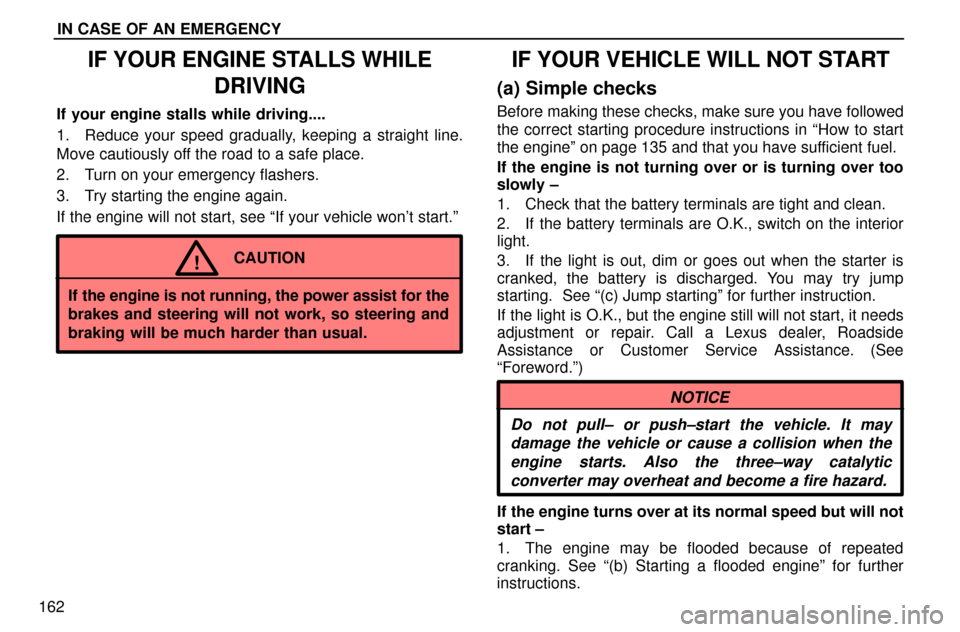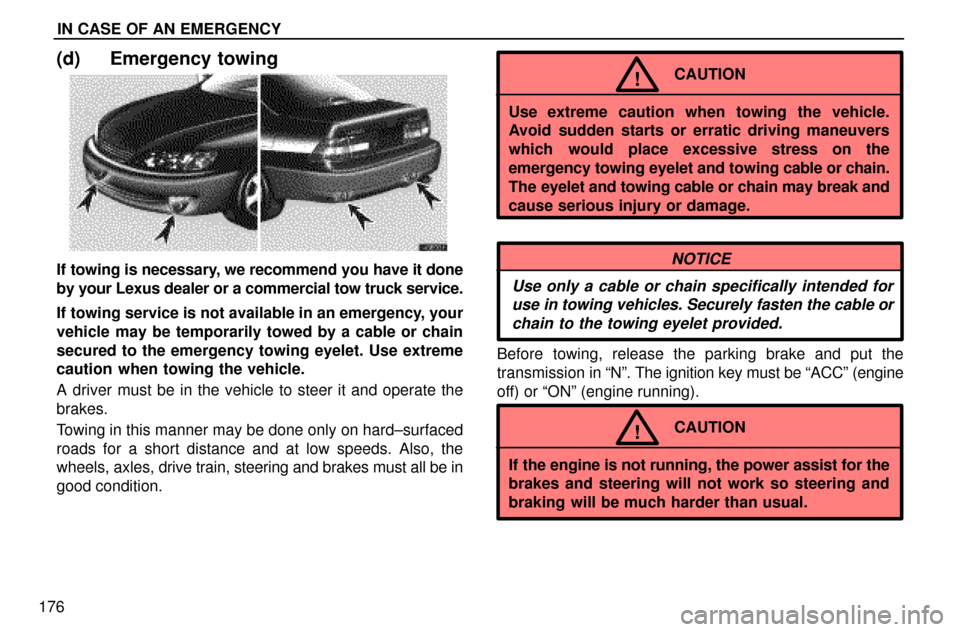steering Lexus ES300 1997 In Case Of An Emergency: In Case Of An Emergency
[x] Cancel search | Manufacturer: LEXUS, Model Year: 1997, Model line: ES300, Model: Lexus ES300 1997Pages: 18, PDF Size: 0.19 MB
Page 2 of 18

IN CASE OF AN EMERGENCY
162
IF YOUR ENGINE STALLS WHILE
DRIVING
If your engine stalls while driving....
1. Reduce your speed gradually, keeping a straight line.
Move cautiously off the road to a safe place.
2. Turn on your emergency flashers.
3. Try starting the engine again.
If the engine will not start, see ªIf your vehicle won't start.º
CAUTION!
If the engine is not running, the power assist for the
brakes and steering will not work, so steering and
braking will be much harder than usual.
IF YOUR VEHICLE WILL NOT START
(a) Simple checks
Before making these checks, make sure you have followed
the correct starting procedure instructions in ªHow to start
the engineº on page 135 and that you have sufficient fuel.
If the engine is not turning over or is turning over too
slowly ±
1. Check that the battery terminals are tight and clean.
2. If the battery terminals are O.K., switch on the interior
light.
3. If the light is out, dim or goes out when the starter is
cranked, the battery is discharged. You may try jump
starting. See ª(c) Jump startingº for further instruction.
If the light is O.K., but the engine still will not start, it needs
adjustment or repair. Call a Lexus dealer, Roadside
Assistance or Customer Service Assistance. (See
ªForeword.º)
NOTICE
Do not pull± or push±start the vehicle. It may
damage the vehicle or cause a collision when the
engine starts. Also the three±way catalytic
converter may overheat and become a fire hazard.
If the engine turns over at its normal speed but will not
start ±
1. The engine may be flooded because of repeated
cranking. See ª(b) Starting a flooded engineº for further
instructions.
Page 16 of 18

IN CASE OF AN EMERGENCY
176
(d) Emergency towing
If towing is necessary, we recommend you have it done
by your Lexus dealer or a commercial tow truck service.
If towing service is not available in an emergency, your
vehicle may be temporarily towed by a cable or chain
secured to the emergency towing eyelet. Use extreme
caution when towing the vehicle.
A driver must be in the vehicle to steer it and operate the
brakes.
Towing in this manner may be done only on hard±surfaced
roads for a short distance and at low speeds. Also, the
wheels, axles, drive train, steering and brakes must all be in
good condition.
CAUTION!
Use extreme caution when towing the vehicle.
Avoid sudden starts or erratic driving maneuvers
which would place excessive stress on the
emergency towing eyelet and towing cable or chain.
The eyelet and towing cable or chain may break and
cause serious injury or damage.
NOTICE
Use only a cable or chain specifically intended for
use in towing vehicles. Securely fasten the cable or
chain to the towing eyelet provided.
Before towing, release the parking brake and put the
transmission in ªNº. The ignition key must be ªACCº (engine
off) or ªONº (engine running).
CAUTION!
If the engine is not running, the power assist for the
brakes and steering will not work so steering and
braking will be much harder than usual.